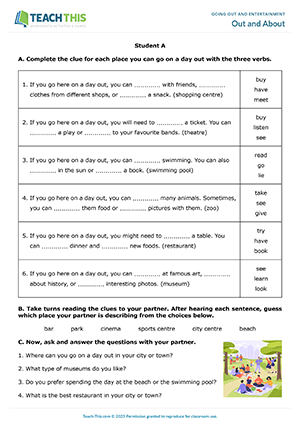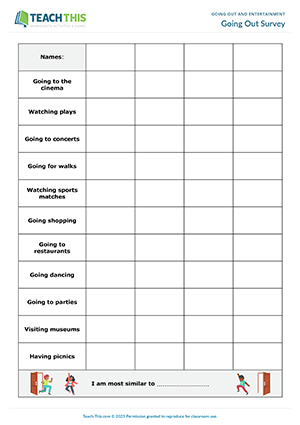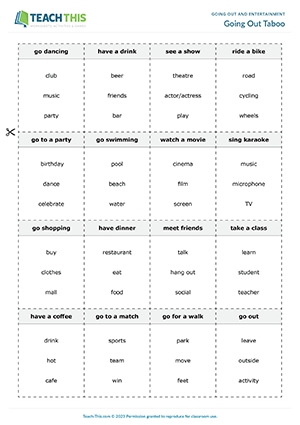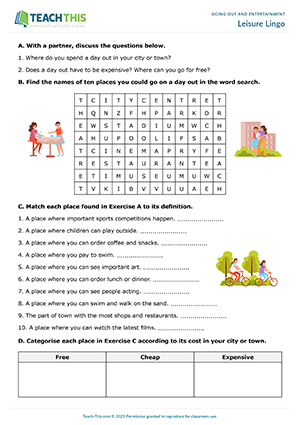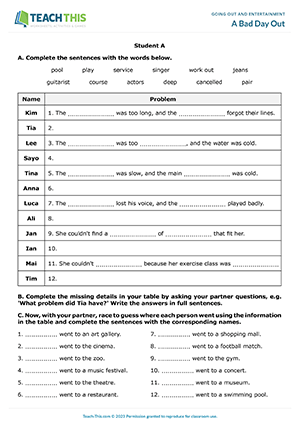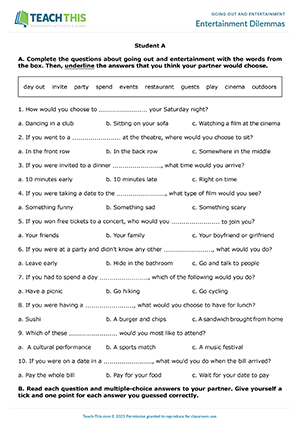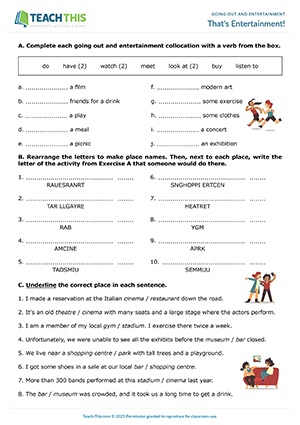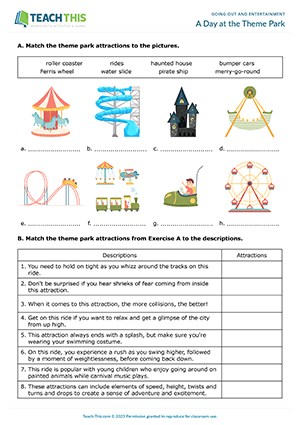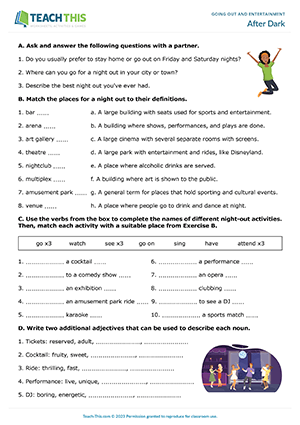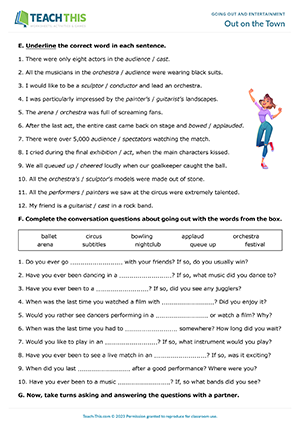This fun going out and entertainment game helps students practice vocabulary for places they can go on a day out and activities associated with these places. First, in two groups, students use verbs to complete clues for different places they can go on a day out. Next, students pair up with someone from the other group and take turns reading each clue to their partner, who guesses which place is being described from the choices provided. For each correct guess, students score one point. The student with the most points at the end of the game wins. Finally, students ask and answer conversation questions about the places with their partner.
This insightful going out survey helps students practice going out and entertainment vocabulary by asking and answering questions about likes and dislikes. First, students find out which activities their group members like to do when they go out by asking Do you like...? questions. The group members respond 'Yes, I do', or 'No, I don't' accordingly, and the student marks the answers in a chart. Next, students pair up with someone from another group and take turns asking their partner who they spoke to and their likes and dislikes using the third person, e.g. 'Does Jon like going to the cinema?' Afterwards, the two students review their answers and complete a sentence on the worksheet with the name of the person they are most similar to. Finally, students report back to the class on their findings.
In this creative entertainment vocabulary game, students describe and guess places and actions related to going out and entertainment. In groups of four, students take turns picking up a card and describing the place or action at the top of the card to the other students without saying any of the words shown on the card. The first student to successfully guess the place or action being described wins and keeps the card. The student with the most cards at the end of the game wins.
In this comprehensive going out and entertainment worksheet, students learn and practice vocabulary related to a day out. In pairs, students begin by discussing two questions about spending a day out. Students then find ten places to go on a day out in a word search. Next, students match the places to their definitions. After that, students categorise each place according to its cost in their town or city. Following that, students match nouns with verbs to make going out and entertainment collocations. Students then use the collocations to complete plans for a day out, adding four ideas of their own. Finally, in pairs, students discuss the plans and answer questions about them. When the students have finished, they share and discuss their answers with the class.
In this engaging going-out information gap activity, students complete sentences about problems people had on a day out and exchange information with a partner to find out where each person went. First, in two groups, students complete sentences about problems people had when they went out to different places with words from a box. Next, students pair up with someone from the other group and take turns asking their partner about the problems experienced by the people whose details are missing from their worksheet and writing their partner's responses in the table in sentence form. After that, pairs race to complete sentences by writing the correct person's name next to the corresponding place or event that they went to. The first pair to complete all their sentences correctly wins.
Here is a free going out and entertainment vocabulary game in which students ask a partner hypothetical questions about going out and guess which answers they would choose. Working alone, students begin by completing questions with words from a box. Next, students underline the multiple-choice answer in each question they think their partner will choose. Students then take turns reading each question along with its three multiple-choice options to their partner, who chooses the answer that is true for them. If students guess correctly, they put a tick next to the question and score a point. The student with the most points at the end of the game wins.
In this productive entertainment vocabulary worksheet, students learn and practice vocabulary related to going out and entertainment. To begin, students complete collocations related to going out and entertainment with verbs from a box. Next, students rearrange letters to spell place names and write the letter of the activity from Exercise A that someone would do at that place. Students then underline the correct place in each sentence. After that, students complete sentences with vocabulary from a box and write the place each sentence refers to. Next, students match sentence halves and complete the endings with words from a box. Lastly, in pairs, students ask and answer conversation questions about going out and entertainment.
In this useful theme park worksheet, students learn theme park vocabulary and engage in theme park discussions by sharing opinions and expressing agreement and disagreement. First, students match theme park attractions to pictures. Students then match each attraction to its description. Next, students sort agreeing and disagreeing phrases into four categories. After that, students read a theme park situation and use the phrases to discuss the positives and negatives of each theme park attraction and come to an agreement for the situation. Finally, students read and discuss statements about theme parks, giving their opinion and saying whether they agree or disagree.
In this handy going out and entertainment worksheet, students practice vocabulary related to having a night out. First, students discuss three questions about nights out in pairs. Students then match places for a night out to their definitions. Next, students use verbs to complete the names of different night-out activities and then match each activity with a suitable place. After that, students write down two additional adjectives that can be used to describe each noun. Following that, students use night-out vocabulary to complete sentences about what people did on Friday night. Finally, students underline the correct word to complete each conversation question and then ask and answer the questions with a partner.
This free entertainment vocabulary worksheet helps students practice words related to going out and entertainment. In pairs, students begin by asking each other conversation questions about going out. Students then match sentence halves to make sentences about going out and entertainment. Next, students match the sentences with activities and underline the correct verb in each sentence. After that, students match verbs with their definitions. Students then underline the correct word in each sentence. Lastly, students complete conversation questions about entertainment and going out with words from a box and then ask and answer the questions with a partner.
Latest Free
Resources
- Everyday Objects Bingo
Everyday Objects
Elementary (A1-A2)
- Action Verb Races
Actions
Elementary (A1-A2)
- Birthday Basics
Birthdays
Elementary (A1-A2)
- Sales Phrasal Verbs
Business Phrasal Verbs
Upper-intermediate (B2)
Latest Member
Resources
- Collocations at Work
Business Collocations
Intermediate (B1)
- Etiquette Trivia Board Game
Etiquette and Manners
Upper-intermediate (B2)
- Everyday Objects Vocabulary
Everyday Objects
Pre-intermediate (A2)
- Let's have a talk
Verb-Noun Collocations
Pre-intermediate (A2)



